A Machine Operator Died When Crushed In A Plastic Injection Molding Machine
Investigation: # 03CA006
SUMMARY
A 48-year-old Hispanic male machine operator died when he was crushed inside a plastic injection molding machine. Evidence suggests the victim was attempting to adjust or repair the machine or one of its components when the incident occurred. Company policy was for machine operators to contact a shift supervisor whenever repair was needed on a machine. The company’s lockout/tagout procedure was not used when this incident occurred. The CA/FACE investigator determined that, in order to prevent future occurrences, employers, as part of their Injury and Illness Prevention Program (IIPP) should:
- Ensure employees stay within their assigned scope of work.
- Ensure machine operators follow company policy and implement the lockout/tagout procedure when applicable.
INTRODUCTION
On May 7, 2003, at approximately 2:30 p.m., a 48-year-old machine operator was killed when he was crushed inside a plastic injection molding machine. The CA/FACE investigator learned of this incident on May 7, 2003, through the Division of Occupational Safety and Health (Cal/OSHA). On May 8, 2003, the CA/FACE investigator traveled to the victim’s place of employment where he interviewed the company vice president and other employees in the plant. The investigator also inspected the incident site and took pictures of the machine involved in the incident.
The employer of the victim was a manufacturer that produced plastic products for the handling, storing, and transporting of products in the agriculture, bakery, beverage, dairy, environmental and materials marketplace. The employer had been in business for over 80 years and had approximately 175 employees. There were 55 employees at the facility where the incident occurred. The victim had been employed with the company for 19 years. The victim was born in Mexico and had lived in the United States for over 20 years. According to the employer, the victim had a 12th grade education and spoke, read, and wrote English.
The employer of the victim had a written safety program with written task specific safe work procedures for all positions in the shop. Employees held weekly tailgate safety meetings with the supervisors and formal safety meetings were held monthly and were documented. The company had a training program. Training was usually accomplished by on-the-job-training (OJT) monitored by the supervisors. Training was usually measured by testing, demonstration, and workmanship. The victim was considered a level 3 operator which meant his duties included troubleshooting the machines’ problems when they developed and taking appropriate action.
INVESTIGATION
The site of the incident was a manufacturing plant that produced industrial plastic products.
The machine involved in the incident was a completely automated plastic injection molding machine. It was mounted on a steel pedestal elevating it approximately 5 feet off the ground. The machine, through a combination of hydraulic and electrical controls, moved a mobile molding plate horizontally onto a static molding plate, forming the desired product. The mobile molding plate was mounted on a track with rollers. When the plates mated, hot liquid plastic was injected into it forming the desired product. After a cooling period, the mobile plate disengaged allowing the freshly molded product to fall out and down onto a conveyor belt. The conveyor belt would then carry the product to the back side of the machine where the operator would remove, trim, and then stack the product.
The operating portion of the machine was completely enclosed for safety. Whenever any regular access panel or door to the machine was opened, the machine would automatically shut off. The pedestal upon which the machine sat was also completely enclosed with the exception of the area where the conveyor belt exited from underneath the machine. The guarding around the pedestal had to be mechanically removed in order to gain access.
On the day of the incident, the victim’s duties consisted of removing the product from the conveyor belt of the machine, trimming the excess plastic off the product, and then stacking it. Around 1:45 p.m., the machine stopped working and its warning lights came on. The victim was not at his work station. Co-workers contacted the supervisor who discovered the victim inside the machine with his head trapped between the pedestal frame and the mobile plate frame. 911 was called and the responding firefighters had to unbolt the guarding around the pedestal frame in order to gain access to the victim and extricate him. Paramedics pronounced the victim dead after they removed him from the machine.
Investigation of the incident site revealed the victim’s tools lying next to the opening in the pedestal where the conveyor belt was located, and several pieces of the machine product laying scattered about the conveyor belt. The guard or shield on the side of the conveyor belt was unbolted on one side. These factors suggest that the victim crawled into the machine from the opening of the conveyor belt not being used. Once inside, he may have attempted to adjust the shield or guard to prevent the product from bouncing off the conveyor belt. Because the area he was in was extremely restrictive (approximately 51”long, 48” wide, and 58”high), he may have tried to stand up when the machine cycled, not realizing that the mobile portion of the mold would cycle backward again. When the machine cycled back, the victim may have been unable to move out of the way and his head got caught between the frame of the pedestal and the frame of the mold.
The victim, being a level 3 operator, had authority to trouble shoot basic machine and processing problems. He also had authority to apply the lockout/tagout procedure in order to prepare the machine for repair by the maintenance department. The lockout/tagout procedure was detailed, and the victim had had refresher training on lockout/tagout just one week prior to the incident. The machine was considered stationary and had operable shut-off devices which were clearly identifiable and visible and accessible. The victim did not use these devices to shut down or lockout/tagout the machine prior to his entrance.
CAUSE OF DEATH
The cause of death according to the death certificate was blunt head trauma.
RECOMMENDATIONS/DISCUSSION
Recommendation #1: Ensure employees stay within their assigned scope of work.
Discussion: In this incident, the victim entered an area that was not in his scope of work. Employees performing work which they are not assigned and for which they are not formally trained may lead to injuries of themselves or others. Safe work practices can be assured through programs of training, supervision, rewards, and progressive disciplinary measures.
Recommendation #2: Ensure machine operators follow company policy and implement the lockout/tagout procedure when applicable.
Discussion: The purpose behind a lockout/tagout procedure is to ensure the release of any stored energy within a machine, then lock that source out while the machine is being worked on to protect the worker. In this case, the victim was trained and authorized to activate the lockout/tagout procedure. Had the victim implemented the lockout/tagout procedure, this incident might have been prevented.
REFERENCES
- California Code of Regulations, Title 8, Sections 3314
FATALITY ASSESSMENT AND CONTROL EVALUATION PROGRAM
The California Department of Health Services, in cooperation with the California Public Health Institute, and the National Institute for Occupational Safety and Health (NIOSH), conducts investigations on work-related fatalities. The goal of this program, known as the California Fatality Assessment and Control Evaluation (CA/FACE) program, is to prevent fatal work injuries. CA/FACE aims to achieve this goal by studying the work environment, the worker, the task the worker was performing, the tools the worker was using, the energy exchange resulting in fatal injury, and the role of management in controlling how these factors interact.
NIOSH funded state-based FACE programs include: Alaska, California, Iowa, Kentucky, Massachusetts, Michigan, Minnesota, Nebraska, New Jersey, New York, Oklahoma, Oregon, Washington, West Virginia, and Wisconsin.
To contact California State FACE program personnel regarding State-based FACE reports, please use information listed on the Contact Sheet on the NIOSH FACE website. Please contact In-house FACE program personnel regarding In-house FACE reports and to gain assistance when State-FACE program personnel cannot be reached.
EXHIBITS
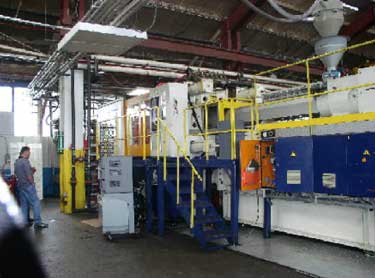 |
|
Exhibit #1. View of the front side of the plastic injector mold involved in this incident.
|
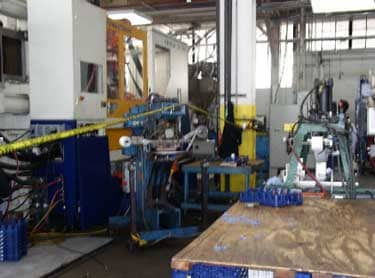 |
|
Exhibit #2. View of the back side of the plastic injector mold involved in this incident.
|
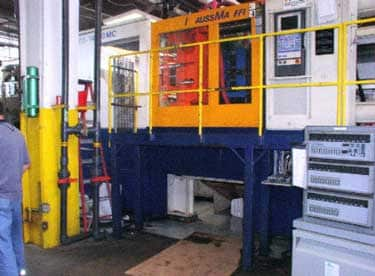 |
|
Exhibit #3. View of the location where the victim entered inside the injector mold.
|
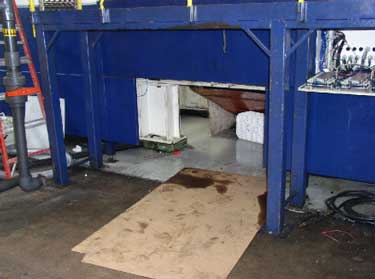 |
|
Exhibit #4. View of the area where the victim removed the conveyor belt to gain access to inside the injector mold. |
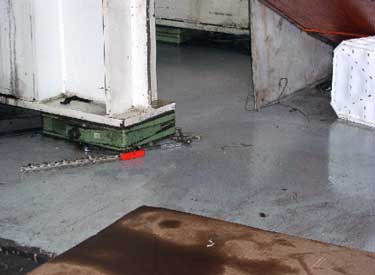 |
|
Exhibit #5. This is a picture of the victim’s tools at the point of entry.
|
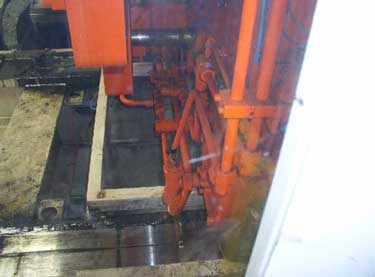 |
|
Exhibit #6. View of the area where the victim was caught looking from the top down.
|
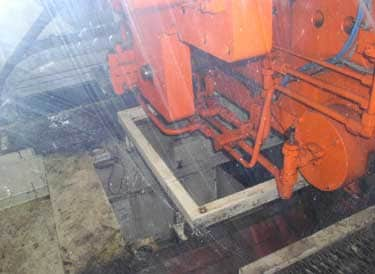 |
|
Exhibit #7. Another view of the area where the victim was caught looking from the top.
|
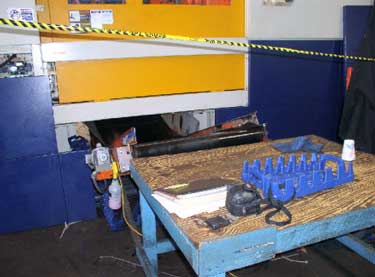 |
|
Exhibit #8. View of the victim’s work area on the back side of the injector mold.
|
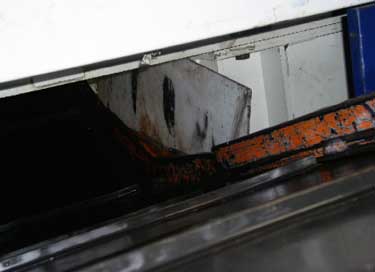 |
|
Exhibit #9. View of the conveyor belt used to catch and transport freshly molded products.
|
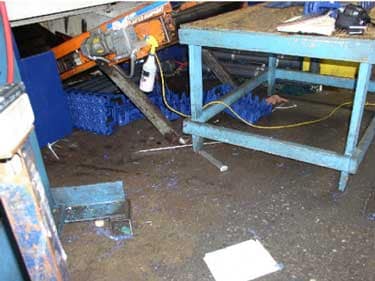 |
|
Exhibit #10. View of the victim’s work station with freshly molded products on floor.
|
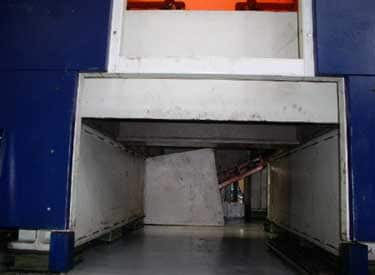 |
|
Exhibit #11. View of the left side of the injector mold with a panel removed to show where the victim was caught.
|
